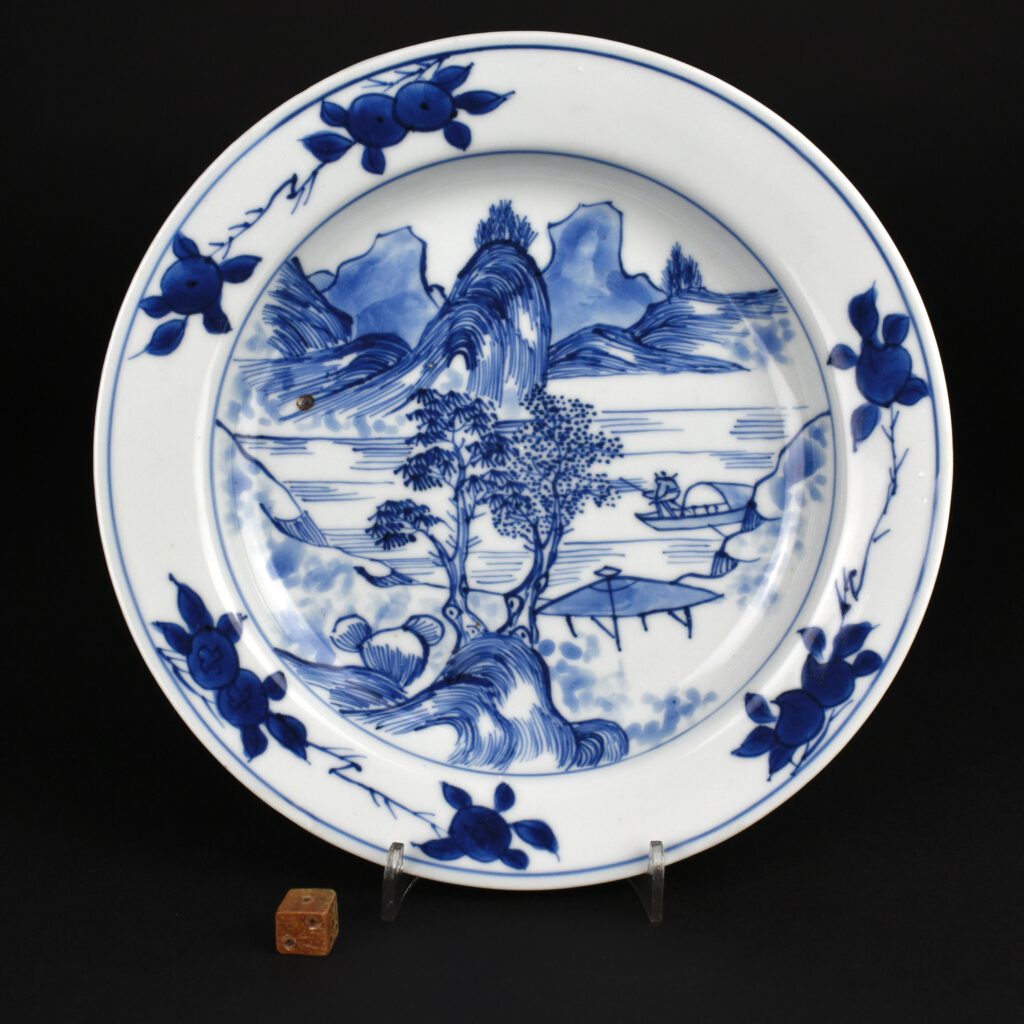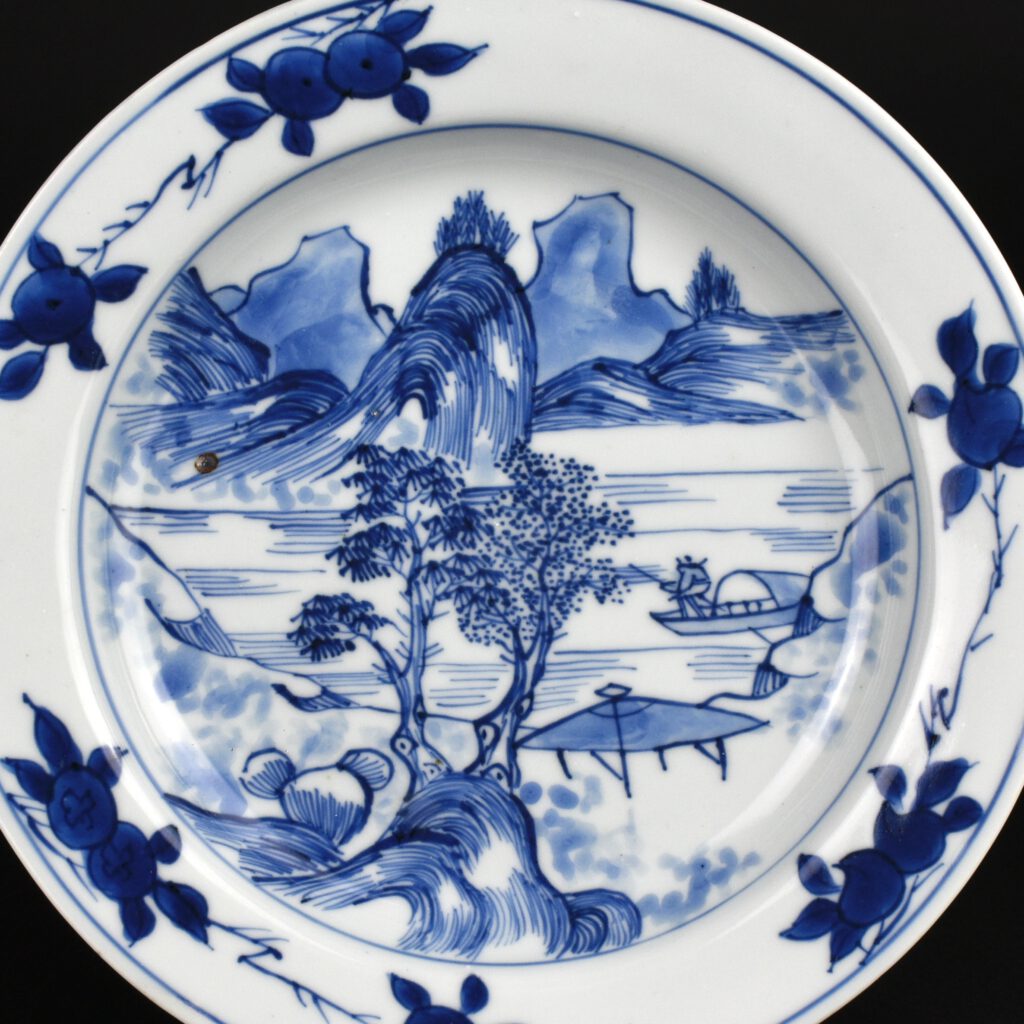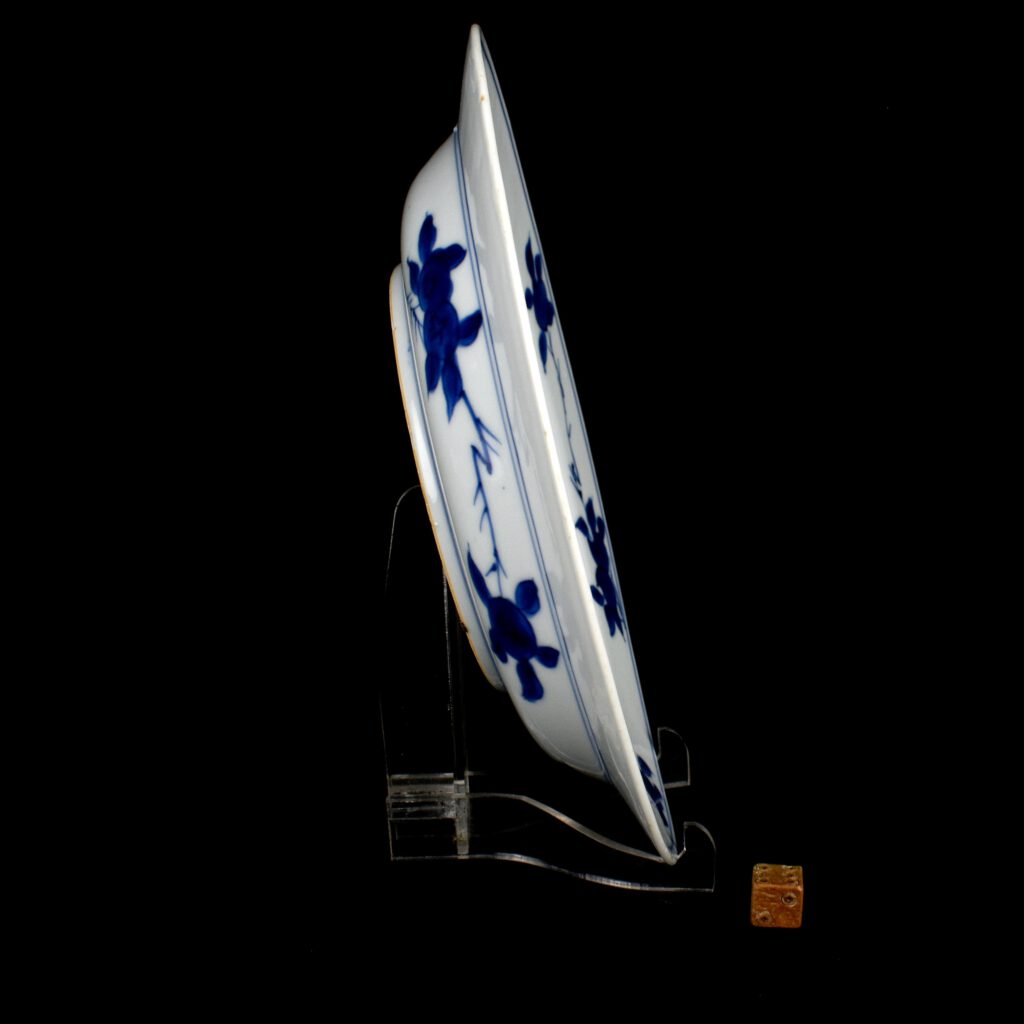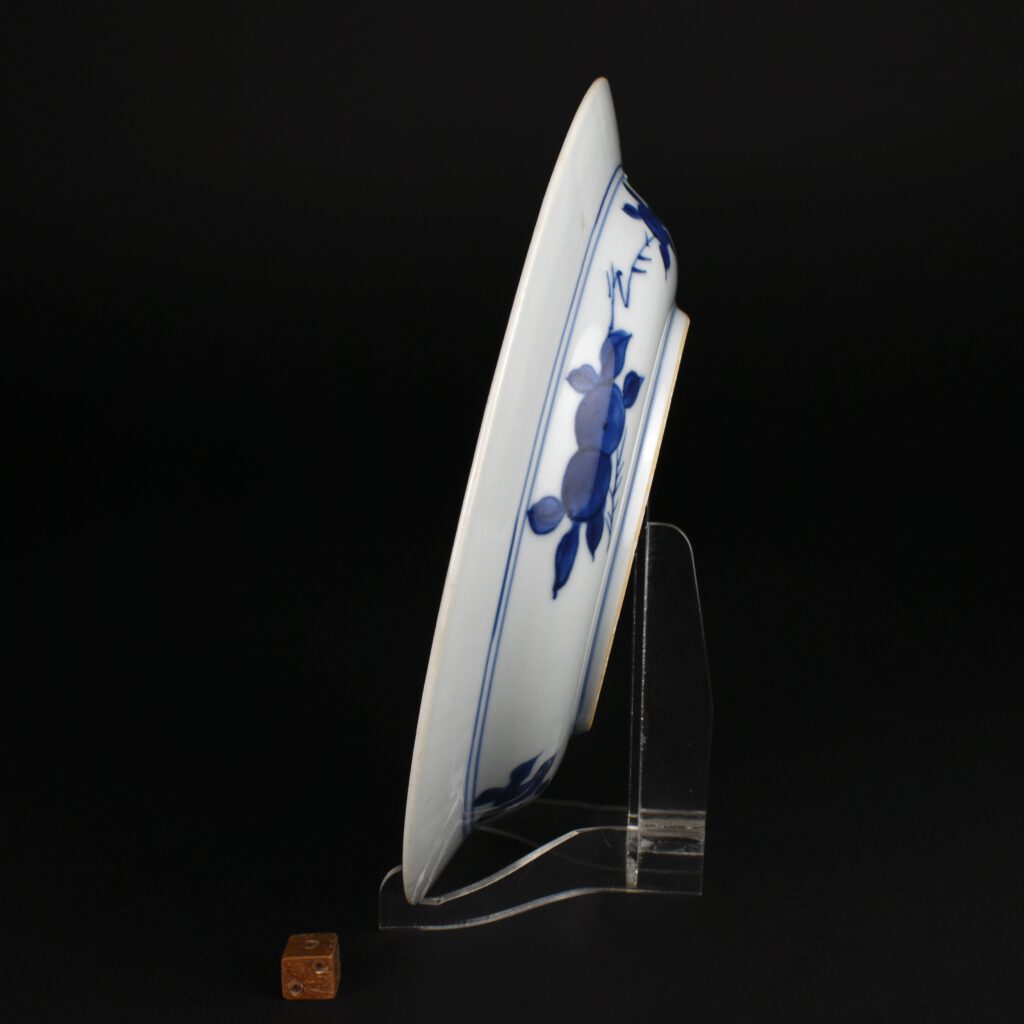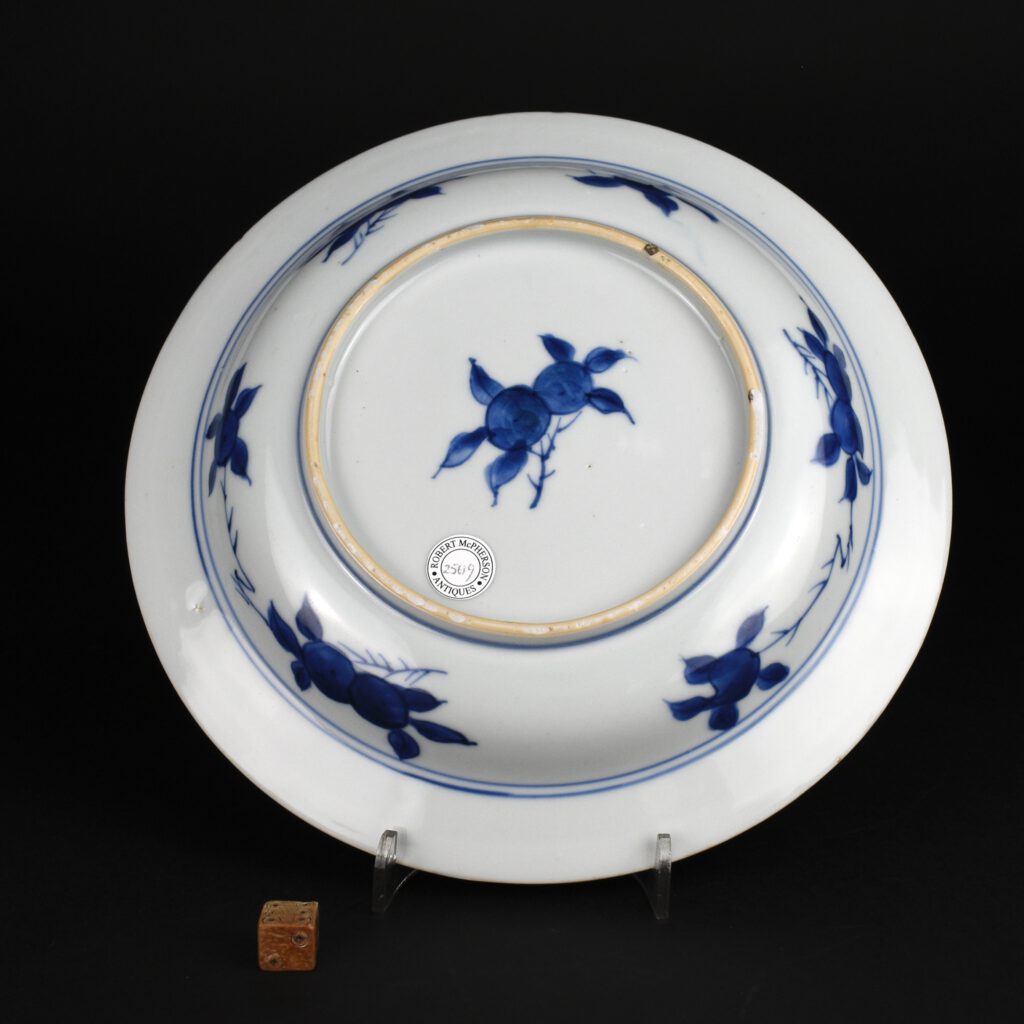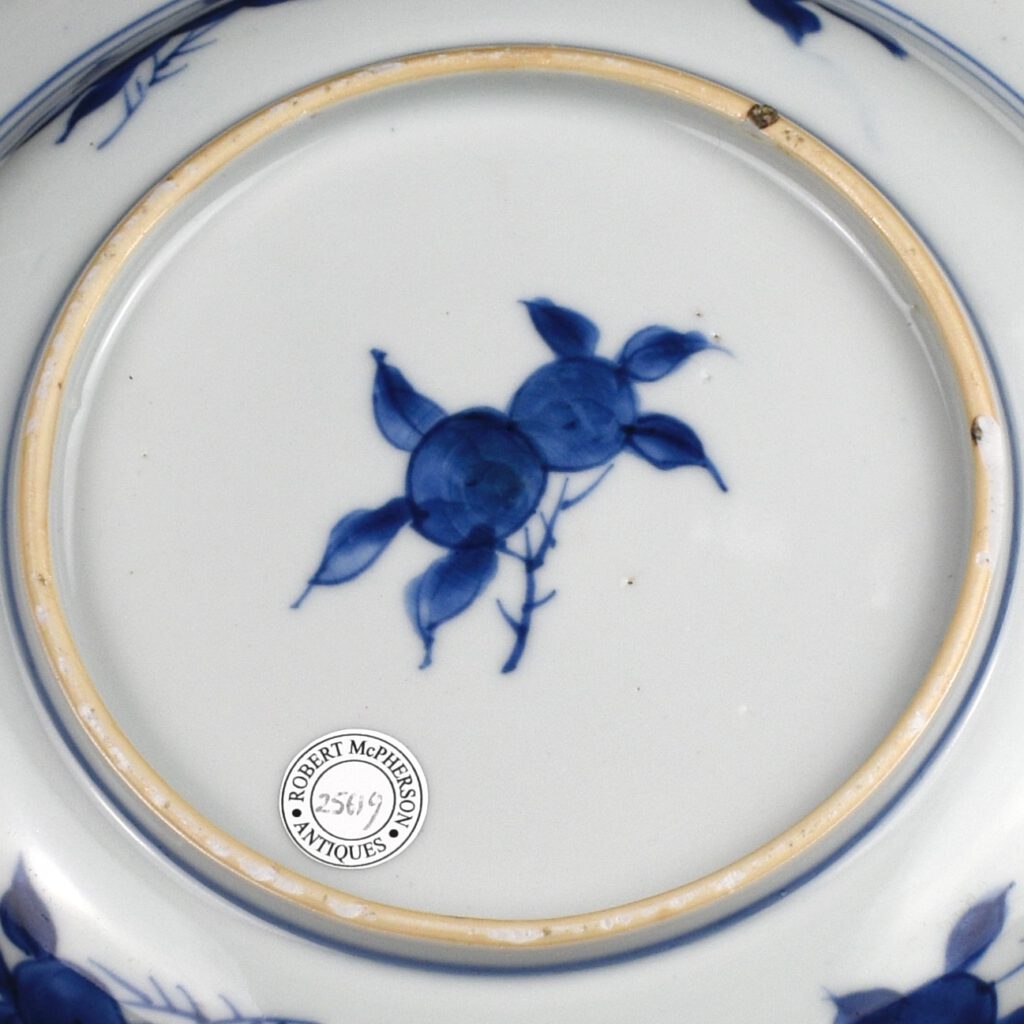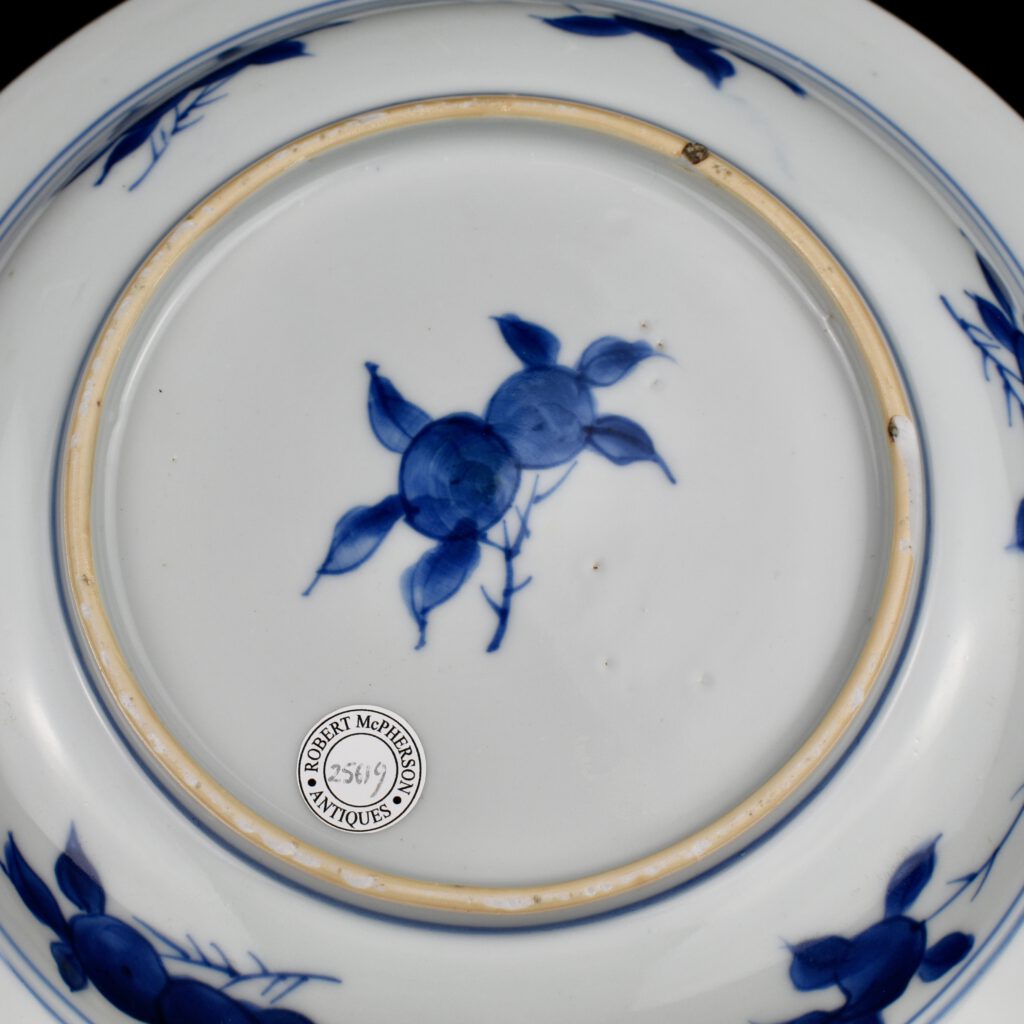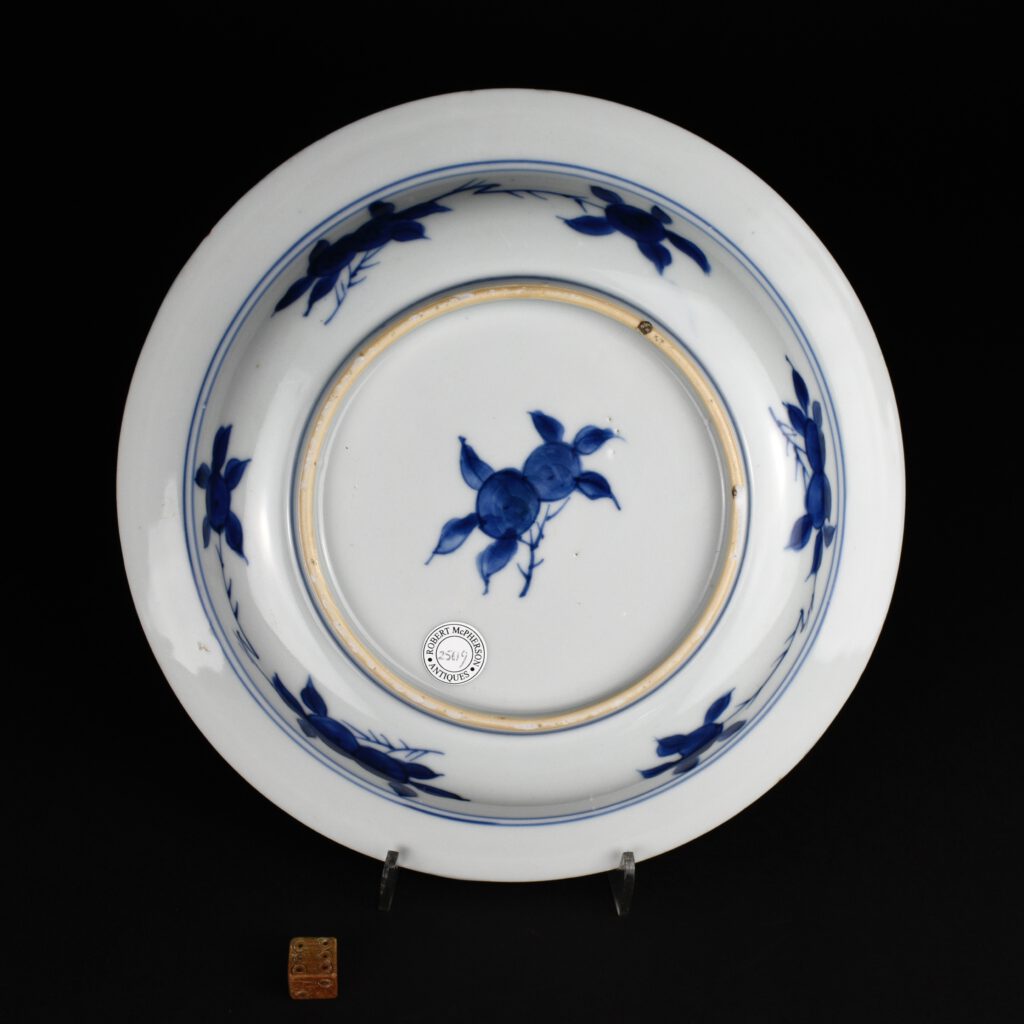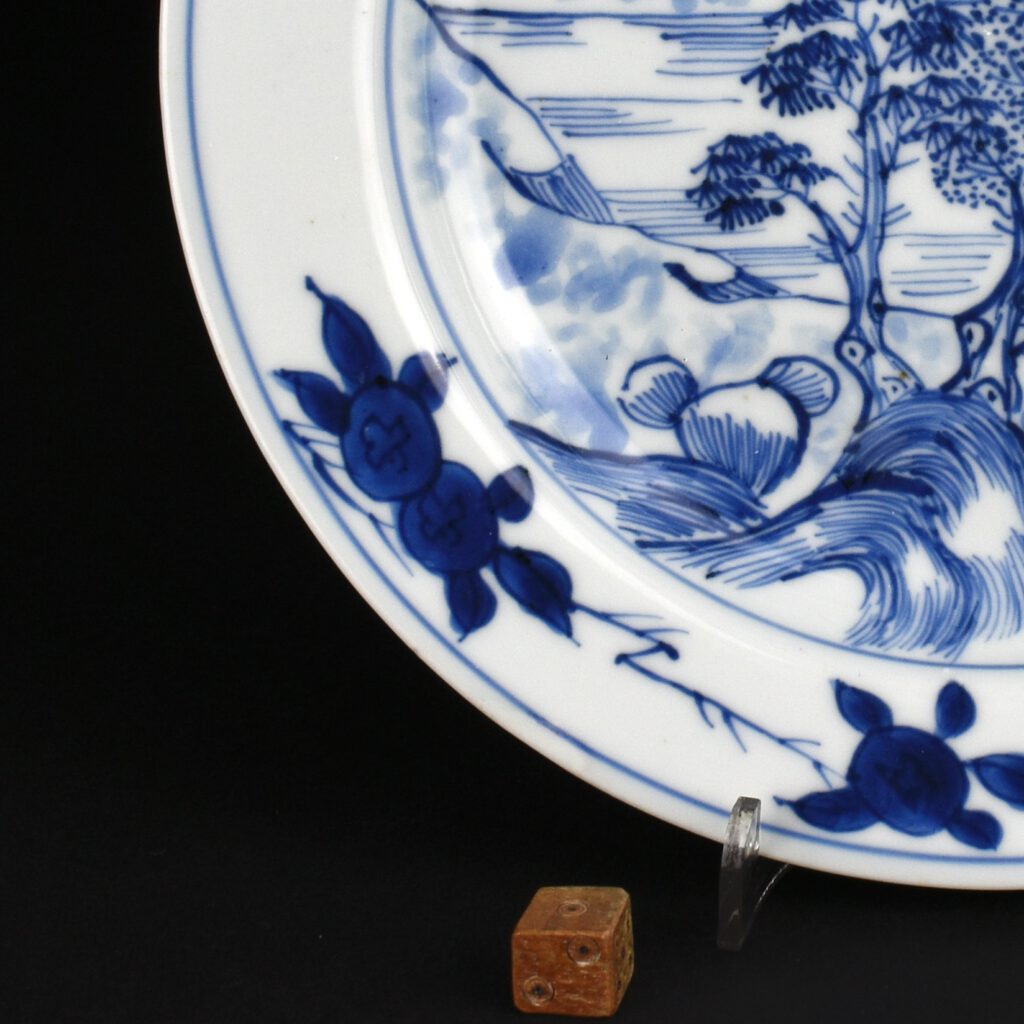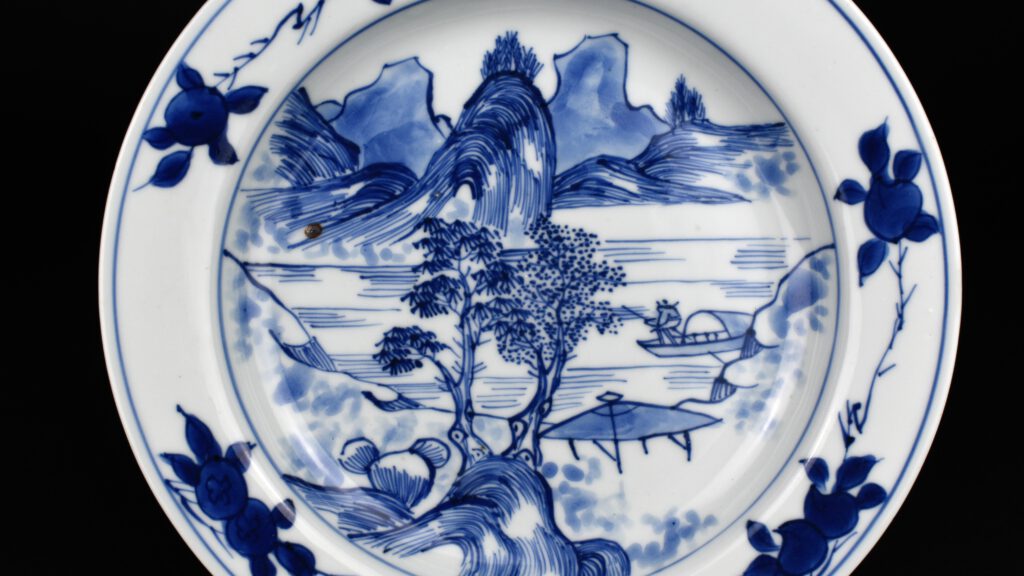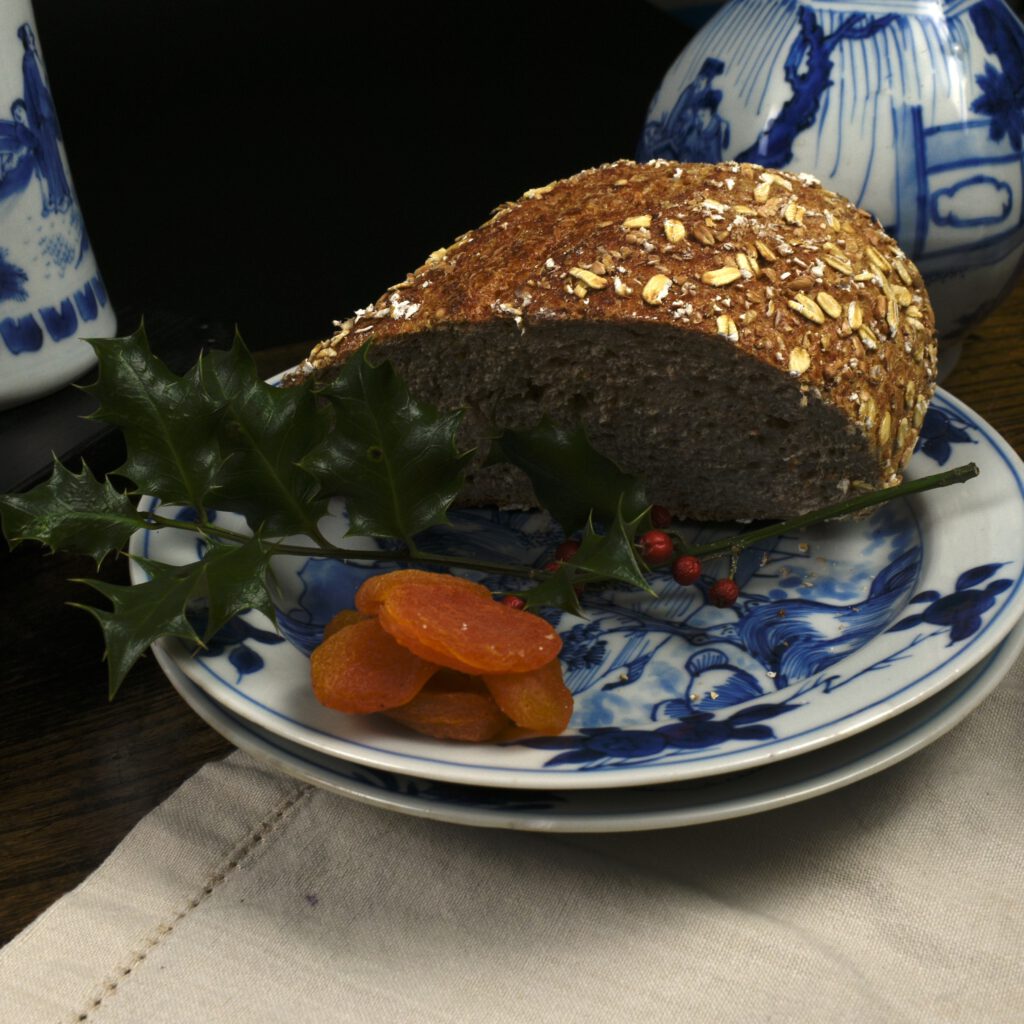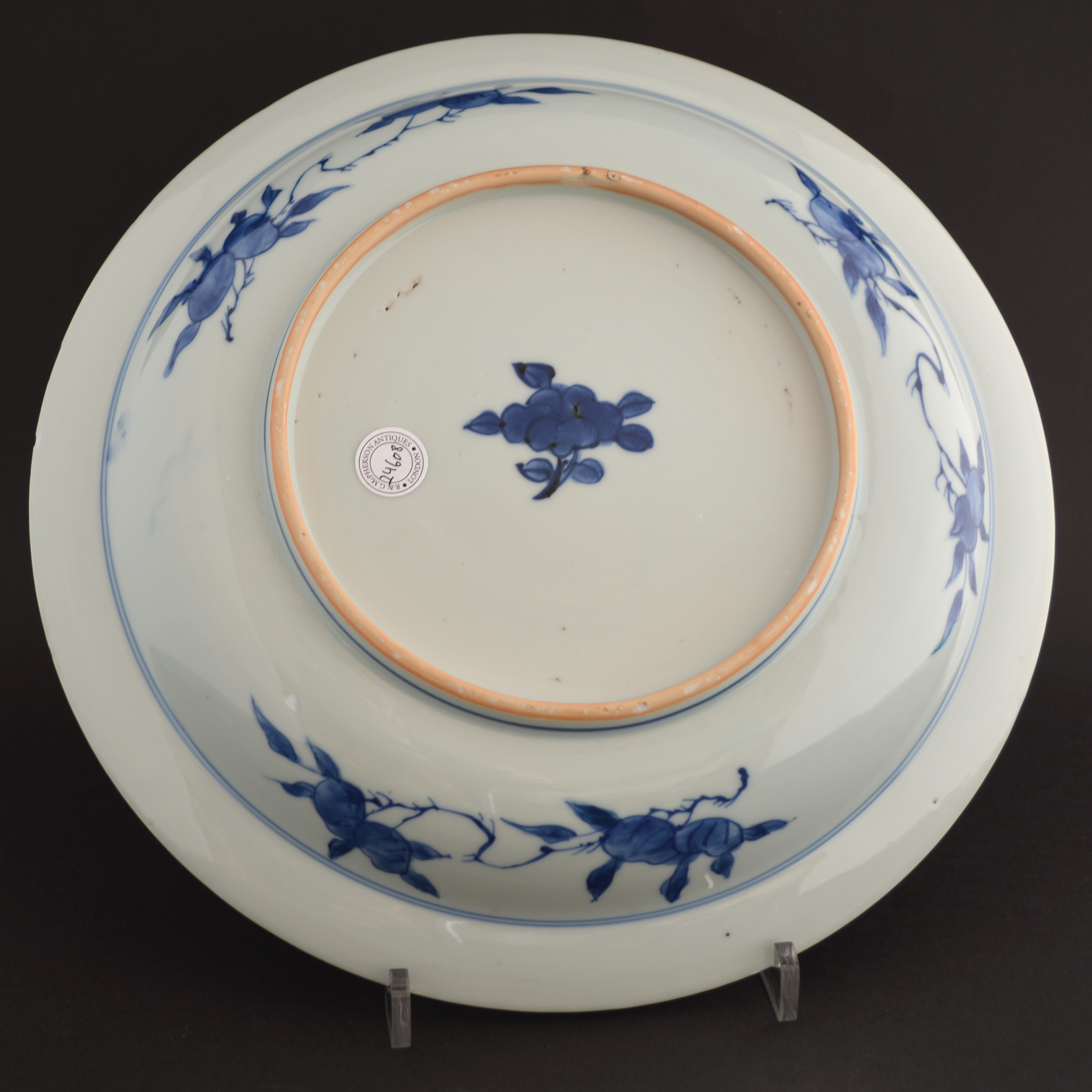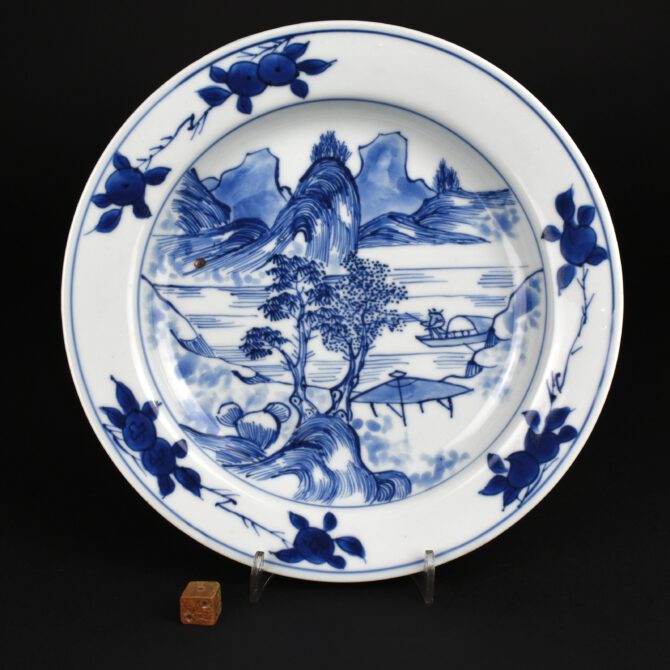
A Transitional Porcelain Plate, Early Kangxi c.1662-1674
A Late Transitional Porcelain Plate, Early Kangxi Period c.1662-1674. This thickly potted Blue and White Porcelain plate is painted with a typical Master of the Rocks scene of the style that was employed the earlier period c.1662-1674. The phrase Master of the Rocks is unfamiliar to many Chinese, it is another invented category used by western scholars and collectors to pigeon-hole groups of Chinese ceramics, rather like Kraakware or Celadon. However unlike either of these Master of the Rocks first coined by Gerald Reitlinger, is a clear, distinct group. This style lasted from about 1645/1650 to the 1690s. The highly distinctive painting style consists of landscapes with massive powerful mountains in a linear technique. The style is, for want of a better word, ‘painterly’ and often includes distant mountains painted with a very wet brush that contrast with the linear mountains in the mid-ground. The style usually employs a technique of blobby dots, either in the landscape or as a border. These dots are painted with a wet brush and have no outline. These designs were certainly inspired by late Ming scroll painters like Wang Jinazhng (active c.1628 – 1644). The same use of brush strokes in contour like parallels lines can be seen. Mountains with jagged peaks are piled up creating a dramatic structure. But where as many of the scroll painters are known, the ceramics artists remain anonymous.
SOLD
- Condition
- There is a thin rim chip filled,It is just above the dice in the close up (it is just above the dice) at its widest it measures 20mm x 4mm. Minute frits and fitting filled in a couple of places.
- Size
- Diameter : 21.8 cm (8 1/2 inches)
- Provenance
- N/A
- Stock number
- 25619
Information
Master of the Rocks
The phrase Master of the Rocks is unfamiliar to many Chinese, it is another invented category used by western scholars and collectors to pigeon-hole groups of Chinese ceramics, rather like Kraakware or Celadon. However unlike either of these Master of the Rocks first coined by Gerald Reitlinger, is a clear, distinct group. This style lasted from about 1645 to 1690. The highly distinctive painting style consists of landscapes with massive powerful mountains in a linier technique. The style is, for want of a better word, ‘painterly’ and often includes distant mountains painted with a very wet brush that contrast with the linier mountains in the mid ground. The style usually employs a technique of blobby dots, either in the landscape or as a border. These dots are painted with a wet brush and have no outline. These designs were certainly inspired by late Ming scroll painters like Wang Jinazhng (active c.1628 – 1644). The same use of brush strokes in contour like parallels lines can be seen. Mountains with jagged peaks are piled up creating a dramatic structure. But where as many of the scroll painters are known, the ceramics artists are anonymous.
A Related Transitional Porcelain Dish.
Early Kangxi Period c.1662-1674.
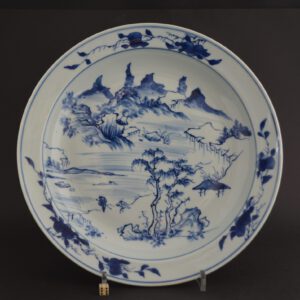
Later Master of the Rocks
Master of the Rocks style porcelain is normally dated to the late Transitional or Early Kangxi Period in the reference books. We have followed this dating with all `Master of the Rocks` porcelain. But I now think plates of this type were made slightly later, after the re-opening of the kilns at Jingdezhen. When one compares the thin potting, rich watery blues and the milky white glaze of these plates to other `Master of the Rocks` pieces they appear quite different. The shape of the plate, thin potting, tones of blue and sheen of glaze relate to Kangxi Porcelain of the 1690`s not the earlier more robust, thickly potted `Master of the Rocks` pieces of the late Transitional or early Kangxi Period. The drawing of the Chenghua mark on the back is also very similar to Kangxi Porcelain of the 1690`s, for example the well know Rotterdam Riot plates of c.1692-1695 whose Chenghua Marks could even be by the same hand.
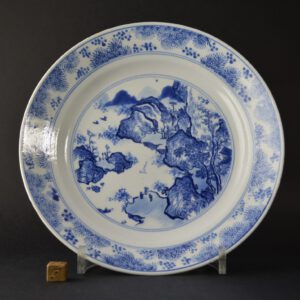
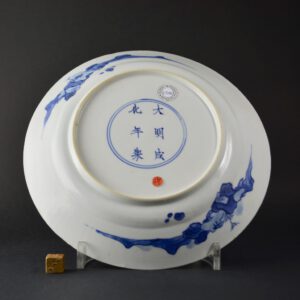
The Transitional Period c.1620 – 1683 :
This is a term used in the West to describe Chinese porcelain made during the turbulent times that befell China in the 17th Century. From the disintegration of the Ming Dynasty and it`s eventual collapse in 1644 through the troubled start of a new `Foreign` Qing dynastic house. The roots of this unsettled period starts during the later part of Wanli`s reign (1573-1620). At the begging of his reign China was doing very well, new crops from the Americas such as peanuts, maize and sweet potatoes increased food production, while simplified taxes helped the state run smoothly. But this was not due to Wanli`s enlightened reign, but to his Mother championing a man that was to become the Ming dynasties most able minister, Zhang Zhuzheng (1525—1583). Wanli became resentful of Zhuzheng`s control but upon his death became withdrawn from court life. Between 1589 to 1615 he didn`t appear at imperial audiences, leaving a power vacuum that was filled by squabbling ministers. Mongols from the North raided as Japan invaded Korea. Wanli re-opened the silver mines and imposed new taxes but the money was lost due to corruption, as well as being frittered away by the indulgent Emperor himself . The next emperor of Ming China, Tianqi (1621-1627), was bought up in this self indulgent disorganised environment, at the very young age 15 his short reign started. He didn`t stand a chance. Tianqi made the mistake of entrusting eunuch Wei Zhongxian (1568-1627) who Anna Paludan in her excellent book “Chronicle of the Chinese Emperors” (Thames and Hudson, 1998) describes as “a gangster of the first order”. Tianqi was deemed to have lost the Mandate of heaven by the Ming people. Tianqi`s younger brother, the last of the Ming Emperors, Chongzhen (1628-1644), was not able to save the situation. The systems of administration had broken down, corruption was rife and so when a sever famine broke out in 1628 nothing much could be done. Anna Paludan describes the tragic end to the great Ming Dynasty “The final drama was worthy of a Greek tragedy. The emperor called a last council in which `all were silent and many wept`, the imperial troops fled or surrendered, and the emperor, after helping his two sons escape in disguise, got drunk and rushed through the palace ordering the women to kill themselves. The empress and Tianqi`s widow committed suicide; the emperor hacked off the arm of one daughter before killing her sister and the concubines. At dawn he laid his dragon robe aside and dressed in purple and yellow, with one foot bare, climbed the hill behind the now silent palace and hanged himself on a locust tree”. The Great Wall of China, started 2,000 years ago was built to protect China from the Northern barbarian hoards, it was often tested and sometimes failed. The Jin people invaded China, ruling the North between 1115 and 1234, it was their descendants the Manchus, Jurchens from south east Manchuria that took full advantage of the problems of the Ming dynasty. In 1636 they adopted a Chinese dynastic name, the `Great Qing` (Qing meaning pure). The first of the Qing emperors was Shunzhi (1644-1661) but for most of his reign his uncle ran the state. War raged on during this period and it wasn`t until the second Qing emperor Kangxi (1662-1722) that true peace was achieved. Kangxi was a wise and educated man, he became a highly successful emperor bringing China a long period of wealth and stability.
